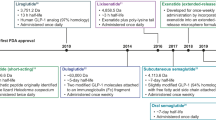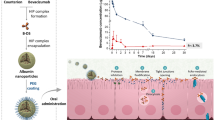Abstract
To develop a colon specific prodrug of celecoxib with improved therapeutic potency and cardiovascular toxicity for chemoprevention of colorectal adenomas, we prepared glycyl celecoxib (GC), aspart-1-ylcelecoxib (A1C) and glutam-1-ylcelecoxib (G1C) and examined colon specific properties in vitro. The amino acid conjugation lowered the apparent partition coefficient of celecoxib (4.6) to 1.2 (GC), 0.6 (A1C) and 0.8 (G1C). The celecoxib-amino acid conjugates were stable in pH 1.2 and 6.8 buffer solutions. On incubation with the contents of small intestine, while GC was stable up to 10 h, A1C and G1C were degraded and liberated celecoxib up to 19–32 % of the dose at 10 h. In the cecal contents, the three conjugates were cleaved to release celecoxib and amounts of celecoxib released from GC, A1C and G1C were 20, 64 and 55 % at 10 h and 30, 75 and 60 % of the dose at 24 h, respectively. Taken together, while GC may deliver celecoxib to the large intestine without premature degradation in the upper intestine, A1C and G1C may have advantages over GC in that they are less absorbable in the upper intestine due to lower partition coefficient and are converted to celecoxib more efficiently at the target site.




Similar content being viewed by others
Abbreviations
- GC:
-
Glycylcelecoxib
- A1C:
-
Aspart-1-ylcelecoxib
- G1C:
-
Glutam-1-ylcelecoxib
- PSI:
-
Proximal small intestine
- DSI:
-
Distal small intestine
- CDI:
-
1,1′-Carbonyldiimidazole
References
Brophy JM (2005) Cardiovascular risk associated with celecoxib. N Engl J Med 352(25):2648–2650 author reply 2648-2650
Chu AJ, Chou TH, Chen BD (2004) Prevention of colorectal cancer using COX-2 inhibitors: basic science and clinical applications. Front Biosci 9:2697–2713
Das D, Arber N, Jankowski JA (2007) Chemoprevention of colorectal cancer. Digestion 76(1):51–67
Davies NM, Gudde TW, de Leeuw MA (2001) Celecoxib: a new option in the treatment of arthropathies and familial adenomatous polyposis. Expert Opin Pharmacother 2(1):139–152
Doherty GA, Murray FE (2009) Cyclooxygenase as a target for chemoprevention in colorectal cancer: lost cause or a concept coming of age? Expert Opin Ther Targets 13(2):209–218
Fischer SM, Hawk ET, Lubet RA (2011) Coxibs and other nonsteroidal anti-inflammatory drugs in animal models of cancer chemoprevention. Cancer Prev Res (Phila) 4(11):1728–1735
Fort J (1999) Celecoxib, a COX-2–specific inhibitor: the clinical data. Am J Orthop (Belle Mead NJ) 28(3 Suppl):13–18
Herendeen JM, Lindley C (2003) Use of NSAIDs for the chemoprevention of colorectal cancer. Ann Pharmacother 37(11):1664–1674
Jalving M, Koornstra JJ, De Jong S, De Vries EG, Kleibeuker JH (2005) Review article: the potential of combinational regimen with non-steroidal anti-inflammatory drugs in the chemoprevention of colorectal cancer. Aliment Pharmacol Ther 21(4):321–339
Jemal A, Siegel R, Ward E, Murray T, Xu J, Thun MJ (2007) Cancer statistics, 2007. CA Cancer J Clin 57(1):43–66
Jung Y, Kim YM (2010) What should be considered on design of a colon-specific prodrug? Expert Opin Drug Deliv 7(2):245–258
Jung YJ, Lee JS, Kim YM (2000) Synthesis and in vitro/in vivo evaluation of 5-aminosalicyl-glycine as a colon-specific prodrug of 5-aminosalicylic acid. J Pharm Sci 89(5):594–602
Jung YJ, Lee JS, Kim YM (2001) Colon-specific prodrugs of 5-aminosalicylic acid: synthesis and in vitro/in vivo properties of acidic amino acid derivatives of 5-aminosalicylic acid. J Pharm Sci 90(11):1767–1775
Jung Y, Kim HH, Kim H, Kong H, Choi B, Yang Y, Kim Y (2006) Evaluation of 5-aminosalicyltaurine as a colon-specific prodrug of 5-aminosalicylic acid for treatment of experimental colitis. Eur J Pharm Sci 28(1–2):26–33
Kim H, Kong H, Choi B, Yang Y, Kim Y, Lim MJ, Neckers L, Jung Y (2005) Metabolic and pharmacological properties of rutin, a dietary quercetin glycoside, for treatment of inflammatory bowel disease. Pharm Res 22(9):1499–1509
Kim IH, Kong HS, Choi BI, Kim YS, Kim HJ, Yang YW, Jung YJ, Kim YM (2006) Synthesis and in vitro properties of dexamethasone 21-sulfate sodium as a colon-specific prodrug of dexamethasone. Drug Dev Ind Pharm 32(3):389–397
Oviedo JA, Schroy PC 3rd (2005) Does celecoxib use increase the risk of cardiovascular events? Gastroenterology 129(4):1348–1350
Raju R, Cruz-Correa M (2006) Chemoprevention of colorectal cancer. Dis Colon Rectum 49(1):113–124 discussion 124-115
Rubinstein A (1990) Microbially controlled drug delivery to the colon. Biopharm Drug Dispos 11(6):465–475
Sinha VR, Kumria R (2001) Colonic drug delivery: prodrug approach. Pharm Res 18(5):557–564
Steinbach G, Lynch PM, Phillips RK, Wallace MH, Hawk E, Gordon GB, Wakabayashi N, Saunders B, Shen Y, Fujimura T, Su LK, Levin B (2000) The effect of celecoxib, a cyclooxygenase-2 inhibitor, in familial adenomatous polyposis. N Engl J Med 342(26):1946–1952
Tive L (2000) Celecoxib clinical profile. Rheumatology (Oxford) 39(Suppl 2):21–28 discussion 57-29
Acknowledgments
This work was supported by a 2-Year Research Grant of Pusan National University.
Author information
Authors and Affiliations
Corresponding author
Rights and permissions
About this article
Cite this article
Lee, Y., Jung, E.H., Kim, H. et al. Preparation and in vitro evaluation of celecoxib-amino acid conjugates as a colon specific prodrug. Journal of Pharmaceutical Investigation 42, 115–120 (2012). https://doi.org/10.1007/s40005-012-0018-3
Received:
Accepted:
Published:
Issue Date:
DOI: https://doi.org/10.1007/s40005-012-0018-3




